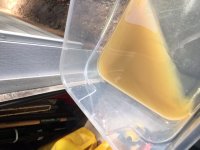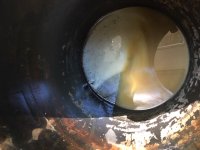Peter 315
Super Member
I would just change the hyd oil with udt/filters add the seafoam and run it check the hyd oil and see how bad it is, If it looks ok run it for 50 hours then change the hyd oil and filters again...:2cents:
LOOSEN THE DRAIN PLUG JUST ENOUGH TO LET IT DRIP. LET IT DRIP INTO A CLEAN CONTAINER. IF IT LOOKS MILKY, YOU SHOULD CHANGE IT. YOU MAY HAVE PUSHED WATER IN THE LEAKY END OF THE CYL WHEN PRESSURE WASHING IT. ALSO PULL THE FILTER AND LET THAT DRAIN TO SEE WHAT COLOR IT IS, IF THAT IS MILKY YOU HAVE WATER THROUGH THE WHOLE SYSTSM. PUT A NEW FILTER IN. IF THE OIL DRAINED FROM THE PLUG AND THE OIL FROM THE FILTER LOOK GOOD, I WOULD GET THE CYL. FIXED AND RUN IT, THEN DO A FILTER CHECK AGAIN. IMHO


The black bucket has the fluid that drained out of the cylinder 2 days ago. I tried not to stir it up when I rotated the bucket to show the white residue on the bottom of the bucket. The second photo is fluid I just now drained out of the drain plug, and it's cloudy too. I'm going to change the fluid and filters. Thanks for the help.View attachment 654664View attachment 654663